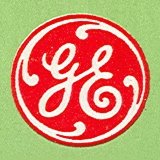



For generations, the General Electric name meant you were getting a quality set
designed to last.
Updated - Here is an EXCELLENT historical
piece on the people at G.E.who developed the holiday lights we all love.
The
link goes to Jeff Carter's Flikr site:
Christmas Lighting Hall of Fame.
You can tell when your set was made by looking for a few clues. The chronology
shown below should help.
1953- Ceramic finish bulbs introduced. These had a ceramic coating that was
fused to the glass, so it couldn't chip.
1957- C9 twinkle bulbs introduced.
Lighted ice bulbs introduced.
1958- C7 twinkle bulbs introduced.
1959- Snowball bulbs introduced.
1963- All green light strings with injection molded sockets introduced and sold
under G.E. brand. Replacement bulbs still sold in 5-packs.
1964- Replacement
bulbs now sold in 4- packs.
1965- Merry Midget line introduced. Early sets made in Japan, then later in
Taiwan.
1969- Satin Glo an earlier metallic finish bulb, discontinued. Replaced by Satin
Bright.
1971- Stardust bulbs introduced.
1972 - Catalog numbers changed to make it easier to identify products. For
example, Satin Bright bulbs went from #D36 to C7-SB. Lighted Bells introduced.
1973- Lighted ornaments introduced.
1977 ENERGESAVER logo introduced to
indicate reduced energy usage, but only used until 1978. Ceramic finish bulbs changed to a painted
coating. Introduced midget sets with a straight line layout and standard wedge base bulbs.
1987- Cartons redesigned. Products made almost entirely overseas.
2001- G.E. discontinued manufacturing of their holiday lighting line and sold it to
Santa's best
craft,
who now make and sell the sets with the familiar trademarks used under license
to G.E.
2012- G.E. Brand lights are now made by Nicolas Holiday, Inc. The
website is
geholidaylighting.com.
Update -Fans of vintage Christmas lighting will be happy to know that you
can still buy G.E.-branded incandescent bulbs in C-7 and C-9 sizes. They are
sold at Lowes home centers and even come in cartons similar to the original
design. I say G.E. branded because they are no longer in the
lighting business. The bulbs are made by another manufacturer under a licensing
agreement.
Go
to: G.E. bulbs at Lowes home centers.
Other products include decorative miniature sets with pine cones,
snowflakes, candles, holly sprigs, and stars. They recently introduced a line of
LED Christmas lights with the "Energy Smart" designation.
How to determine date by Bulb packaging.
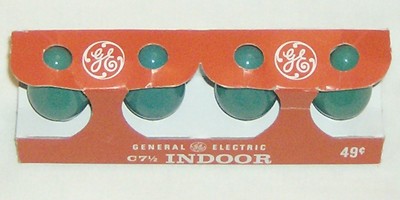 |
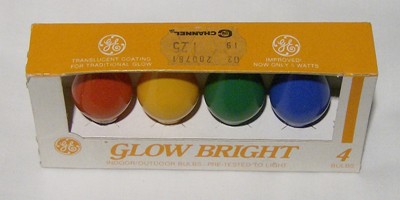 |
| Prior to 1975, G.E. replacement bulbs were packaged in a carton style which allowed the tips of the bulbs to show. | After 1975 the cartons were changed to enclose the bulb tips, because all bulbs now used a paint finish which scratched easily. |
Here are some G.E. advertising items.
|
In 1963 G.E. introduced their own new, all green light
sets. To showcase their features this 5 panel graphic appeared on Christmas light sets. |
 |
|
Here's a classic G.E. ad from the December 1969 Readers Digest magazine. In it, Santa's little helper implores Mom to buy G.E. Satin Brights because "They shine even when they're off !" |
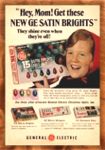 |
|
Here is a merchandising display for General
Electric Christmas light bulbs. It shows the various decorative bulbs offered by
G.E. at the time and even lights up! These photos are from an eBay auction which sold in November 2007. I usually don't use eBay photos, but am making an exception here because this is a rare item. |
 |
|
This advertisement from the December 5, 1960 issue of LIFE magazine is a gold
mine of information on G.E. lamps sold at the time. The ad fills 2 full pages and they certainly got their moneys worth since it was in a sports issue. |
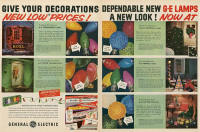 |
|
The flyer announcing General Electric's new design for Chrisrmas Light sets,
introduced in 1963. Note that replacement bulbs were still sold in packs of 5. Provided by Jeff Carter. |
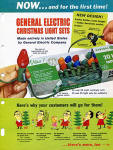 |
|
Here is the 1968 General Electric Catalog, provided by Jeff Carter. At this
time, they were now selling bulbs in packs of 4, and had introduced the Merry
Midget line of miniature sets. |
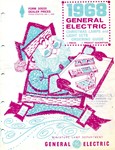 |
|
This is the 1978 G.E. retailer catalog, kindly provided by collector Jeff
Carter. It firmly establishes1978 as the beginning of the ENERGE SAVER era, when G.E.started trimming their product line and sending manufacturing overseas. The catalog is in Adobe PDF format so you will need Adobe reader to view it. |
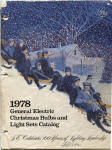 |
|
This 1979 G.E. catalog is also provided by Jeff Carter. It needed lots of
restoration work to remove markings. In this holiday season, General Electric
enlisted the help of Mr. Magoo to sell their products. Unfortunately, the catalog is missing two pages. Page 2, G.E.'s extra margin of quality, and page 3, the order form. No doubt this was sent in with a BIG order for G.E. Christmas lights. |
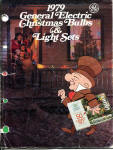 |
| A timeline of General Electric Christmas decorating products provided by collector Jeff Carter. | G.E. products timeline. |
More vintage advertisements can be found in the recently launched Google
archives of
LIFE magazine.
G.E. advertised there in the 1960s using sidebar ads. See Dec. 10 1965 pg. 70,
and Dec 09 1966 pg. 144 for Lighted ice ads.
Check out Dec 8 1967 pg. 124, Dec 6 1968 pg. 10 and Dec 12 1969 pg. 2. Go to
Dec 5 1960 pages 76 and 77 for a 2 page ad!
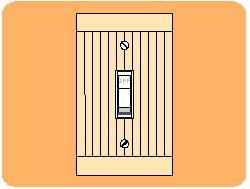 |
Click on the light switch to the left to
enter the gallery
where you'll see many of these sets and bulbs lit up! (Broadband recommended) |
Click on the mini image to see the full size version, then use your browsers back button to return.
Got broadband? click here! > The pre 1963 era. (You'll see the same photos as below all on one page.)
|
Here are the oldest bulbs in my collection, a 5
pack of C-9 ceramic bulbs. Looking at the back, the lack of a ZIP code dates the pack to pre 1963, while the patent cited dates it to after 1956. The original colors were white, red, yellow, green, and blue. |
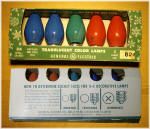 |
| Here are 4 hard to find flame style bulbs in C-9 size. As you can see, the bulb on the right has a brass base. G.E. bulbs with brass bases date to pre 1957. These bulbs have their color coating on the inside. For more information, see U.S. Patent # 1900463. |
 |
|
Here are 3 G.E. Snowball bulbs from the 1950s.
"They're white - till they light!" These are G14 globe bulbs with a clear color coating, then over that is white Styrofoam. The colors from L-R are red, violet, white, yellow, and blue. |
 |
Got broadband? click here! > Bulbs sold from 1963 to 1978. (You'll see the same photos as below all on one page.)
| G.E. Glow Bright C7-CC, 1953 to 1978. These bulbs had a glazed ceramic like finish that would never chip or fade, but they also got very hot! Note the round G.E. logo at the base of the bulbs. |
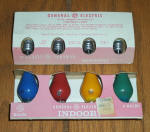
|
| Lighted G.E. Twinkle Bright. |
   
|
| G.E. Satin Glo #D23. These early bulbs had a nice metallic shine to them, but when lit up, they looked like regular Christmas light bulbs. How do you tell them apart? Satin Glo was marked with the G.E. logo and D23 on the bulbs, and Satin Bright was not. |
 |
 G.E.
Satin Bright C7-SB, formerly #D36. These Bulbs had a Metallic appearance and they really did "Shine even when
they're off" as their advertisement said. When lit, the bulbs appeared slightly
transparent. Unfortunately it's difficult to capture this effect on film. G.E.
Satin Bright C7-SB, formerly #D36. These Bulbs had a Metallic appearance and they really did "Shine even when
they're off" as their advertisement said. When lit, the bulbs appeared slightly
transparent. Unfortunately it's difficult to capture this effect on film. Update: Satin finish bulbs are now available as LED retrofit bulbs. |
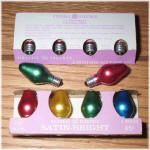 |
| G.E. Satin Bright vs. Kmart. This picture shows a comparison of the G.E. lamps - top with K-Mart's offering for the 2002 -2004 Christmas season - bottom. The colors are strikingly similar (note that K-Mart has added a pink color). The base materials are different while the G.E. bulbs are a true cone shape and the Kmart ones are torpedo shaped. |
 |
|
A package of C-6 Bulbs made in Mexico, 1970s. C-6 bulbs were discontinued in 1977. They're all orange so these bulbs were probably intended for candelabras. |
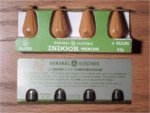
|
| General Electric Lighted Ice bulbs #D30 introduced in 1960 and sold until 1997. These had plastic "ice" crystals on G14 candelabra base globe bulbs. The colors are (L-R) Ruby, Garnet, Topaz, Emerald, and Turquoise. When lit, they looked like snowballs. Check the price sticker - 19 cents! For more information, see U.S. Patent # 2946911. |
 |
| Another variation is these stardust bulbs which date to the 1960s. They're torpedo shape bulbs with a glitter finish. It's no coincidence that these bulbs are the same shape as torpedo chandelier bulbs. That's so they could be manufactured using existing equipment. |
 |
|
G.E. Lighted bells,
#C7-LB, 1972 -1977. Those folks at G.E. sure liked glitter! These ornaments had a C-7 transparent finish bulb cemented inside a glitter coated plastic bell, which makes replacing the bulbs a challenge. Click here for a technique to replace the bulbs. |
 |
| G.E. Lighted bells #C7-LB, 1972 -1977, in the original packaging. These ornaments were also sold with a light string included. |
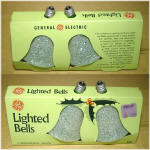 |
| G.E. Merry Bright bulbs in C-9 intermediate base size, Catalog C9-MB formerly D15. These are steady burning bulbs with a transparent finish which are often confused with twinkle bulbs. Once the bulbs escape from their packaging, the only way to tell them apart is to examine the elements inside. The Merry Bright name was only used on C-9 size bulbs, while the Cool Bright name was used on C-7 size bulbs. |
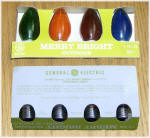 |
|
G.E. Merry Twinkle bulbs in C-9 intermediate
base size, Catalog # D27. The bulbs were made in
the USA and had a different design which resulted in a faster flash rate than
today's bulbs. The Merry Twinkle name was used until 1977 when it then became Twinkle Bright. |
 |
Got broadband? click here! > Bulbs sold from 1978 to 1987. (You'll see the same photos as below all on one page.)
Got broadband? click here! > Bulbs sold from 1987 to 2001. (You'll see the same photos as below all on one page.)
< Prev Page | Home | Next Page >
Merry Midget Light sets.
| Reflector Lights | G.E. Lights and bulbs | Light set repair |
| Assorted Rarities | Tree Toppers | Bubble Lights |
| The Yule Blog | Web Links | Ornaments |
| Vintage sets | Light bulb testing | How old is it? |